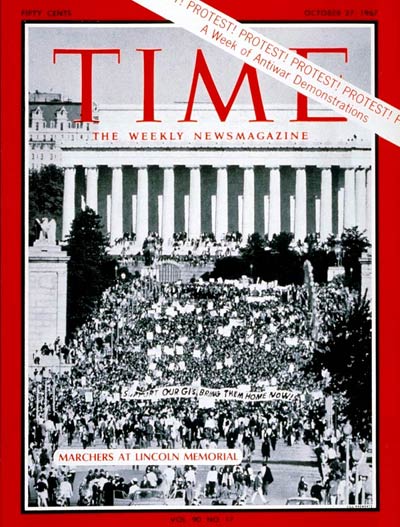
Milestone moments do not a year make. Often, it’s the smaller news stories that add up, gradually, to big history. With that in mind, in 2017 TIME History will revisit the entire year of 1967, week by week, as it was reported in the pages of TIME. Catch up on last week’s installment here.
Thirty-five years after President Herbert Hoover called troops to Washington, D.C., to suppress the protests of the so-called Bonus Army, the military was again called in to control a crowd in the nation’s capital. This time it was the tens of thousands of protesters who massed to demonstrate against the war in Vietnam. Hundreds were arrested and more than a dozen injured over the course of the biggest peace protest in D.C. history to that point, which came at the apex of a week of protest across the nation and the world.
“Within the tide of dissenters swarmed all the elements of American dissent in 1967: hard-eyed revolutionaries and skylarking hippies; ersatz motorcycle gangs and all-too-real college professors; housewives, ministers and authors; Black Nationalists in African garb—but no real African nationalists; nonviolent pacifists and nonpacific advocates of violence—some of them anti-anti-warriors and American Nazis spoiling for a fight,” TIME noted in a cover story on the protests.
So it was unsurprising, in a way, that while the American mainstream recoiled from the more extreme views expressed at the protest, the general feeling that there was something worth protesting was widespread. Though some potential attendees had backed out over concern that the mood of the demonstration was tilting toward general anti-Americanism, the umbrella group organizing the event (the National Mobilization Committee to End the War in Viet Nam) had specifically attempted to “reconcile plans for civil disobedience with more moderate notions of a legal rally.”
Amid all the marching and arguing over principles, however, it was one of the more outré moments of the day that would end up becoming the first thing mentioned in the story and the primary thing remembered by much of history: the attempt to levitate the Pentagon. In fact, the hippies who staged that bit of political theater had received an official (if tongue-in-cheek) permit from the government, TIME reported, to raise the building as much as 10 feet off the ground.
The Pentagon stayed on the ground and, at least in TIME’s view, the American values embodied by the protesters stayed intact:
For all the sound and fury, the antiwar spectaculars were a remarkable—if little noted—tribute to the vitality and viability of American society. Through all the weeks of negotiations between the manipulators of dissent and the federal Establishment over permits to demonstrate and the designation of parade routes, the U.S. Government never once challenged the marchers’ right to present themselves and their case in Washington.
Spy story: In a story seemingly ripped right from the pages of a John le Carré novel, the world news section reported that a high-ranking KGB official who had posed as a jukebox salesman to operate multiple spy rings had defected, contacting the CIA in West Berlin to ask for asylum and offer up his knowledge. While U.S. intelligence would ordinarily trumpet such a victory, they’d kept it quiet for a surprising reason: bitterness that West Germany had stolen the honor of breaking the news.
Let it grow: This week’s essay tackles a hairy topic — literally. Though The Beatles and the hippies may have started the trend, American men across the country were making longer hair respectable. A trade magazine for barbers had changed its title to accommodate men’s hairstylists, and psychologists theorized that men were embracing nature’s dictum for birds, that the male of the species ought to show off his feathers. What would be next? Perhaps a vogue for longer beards and mustaches (the latter of which was borne out in the 1970s) or, in a backlash to the mainstreaming of the mop, bald would soon be big.
A borrower be: This tidbit from the “People” section is worth clicking through for the photo. The pianist Van Cliburn, who was 6-foot-4, had lost his luggage just before a concert in Washington, D.C., and it was too late to rent a tux. Desperate to find a tall enough man in possession of a suitably formal tailcoat, he landed in the natural place: the White House, where he borrowed a suit from President Johnson.
Rave review: Tom Stoppard’s Rosencrantz and Guildenstern Are Dead has since become a theatrical classic, and TIME’s reviewer wouldn’t be surprised to hear so, as the play earned high praise for its Broadway opening. “[It] is one of those rare plays able to open worlds of art, life and death,” the critic wrote. “The sun of this drama is coruscating wit and laughter; its shade is melancholy death. Broadway may not see a more auspicious playwriting debut this season.”
Great vintage ad: Quite an argument for buying a fancy camera: “Trouble is, the best things in life are either illegal, immoral, fattening or cost $160.”
Coming up next week: Buckley’s Conservatism
More Must-Reads from TIME
- Where Trump 2.0 Will Differ From 1.0
- How Elon Musk Became a Kingmaker
- The Power—And Limits—of Peer Support
- The 100 Must-Read Books of 2024
- Column: If Optimism Feels Ridiculous Now, Try Hope
- The Future of Climate Action Is Trade Policy
- FX’s Say Nothing Is the Must-Watch Political Thriller of 2024
- Merle Bombardieri Is Helping People Make the Baby Decision
Write to Lily Rothman at lily.rothman@time.com